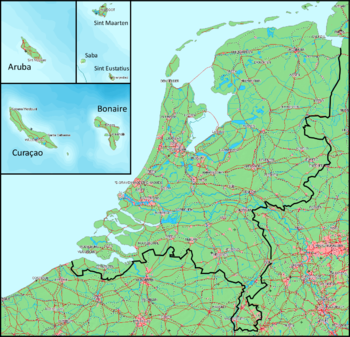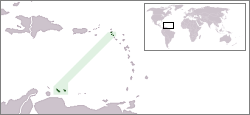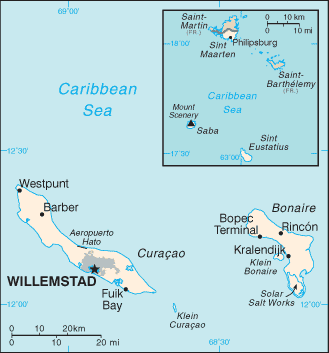Netherlands Antilles
2008/9 Schools Wikipedia Selection. Related subjects: Americas; Countries
| Nederlandse Antillen Antia Ulandes Antia Hulandes Netherlands Antilles
|
||||||
|---|---|---|---|---|---|---|
|
||||||
| Motto: Libertate unanimus (Latin: "Unified by freedom") |
||||||
| Anthem: Anthem Without a Title |
||||||
|
|
||||||
| Capital (and largest city) |
Willemstad |
|||||
| Official languages | Dutch, English, Papiamento | |||||
| Government | ||||||
| - | Monarch | Queen Beatrix | ||||
| - | Governor | Frits Goedgedrag | ||||
| - | Prime Minister | Emily de Jongh-Elhage | ||||
| constitutional monarchy | part of the Kingdom of the Netherlands | |||||
| Area | ||||||
| - | Total | 800 km² ( 184th) 309 sq mi |
||||
| - | Water (%) | Negligible | ||||
| Population | ||||||
| - | July 2005 estimate | 183,000 ( 185th) | ||||
| - | Density | 229/km² ( 51st) 593/sq mi |
||||
| GDP ( PPP) | 2003 estimate | |||||
| - | Total | $ 2.45 billion ( 180th) | ||||
| - | Per capita | $ 11,400 (2003 est.) ( 79th) | ||||
| HDI (2003) | n/a (unranked) ( n/a) | |||||
| Currency | Netherlands Antillean guilder ( ANG) |
|||||
| Time zone | ( UTC-4) | |||||
| Internet TLD | .an | |||||
| Calling code | +599 | |||||
The Netherlands Antilles (Dutch: Nederlandse Antillen ), previously known as the Netherlands West Indies or Dutch Antilles/West Indies, is part of the Lesser Antilles and consists of two groups of islands in the Caribbean Sea: Curaçao and Bonaire, just off the Venezuelan coast, and Sint Eustatius, Saba and Sint Maarten, located southeast of the Virgin Islands. The islands form an autonomous part of the Kingdom of the Netherlands. The islands' economy depends mostly upon tourism, international financial services, international commerce and shipping and petroleum.
The Netherlands Antilles was scheduled to be dissolved as a unified political entity on 15 December 2008, so that the five constituent islands will attain new constitutional statuses within the Kingdom of the Netherlands. This dissolution is still planned, but has been postponed to an indefinite future date.
History
Both the leeward ( Alonso de Ojeda, 1499) and windward (Christopher Columbus, 1493) island groups were discovered and initially settled by Spain. In the 17th century, the islands were conquered by the Dutch West India Company and were used as military outposts and trade bases, most prominent the slave trade. Slavery was abolished in1863.
In 1954, the status of the islands was up-graded from a colonial territory to a part of the Kingdom of the Netherlands as a separate country within the kingdom. The island of Aruba was part of the Netherlands Antilles until 1986, when it was granted status aparte, becoming yet another part of the Kingdom of the Netherlands as a separate country within the kingdom.
Between June 2000 and April 2005, each island of the Netherlands Antilles had a referendum on its future status. The four options that could be voted on were:
- closer ties with the Netherlands
- remaining within the Netherlands Antilles
- autonomy as a country within the Kingdom of the Netherlands (status aparte)
- independence
Of the five islands, Sint Maarten and Curaçao voted for status aparte, Saba and Bonaire voted for closer ties to the Netherlands, and Sint Eustatius voted to stay within the Netherlands Antilles.
The full results were:
| Island | Date of referendum | Vote for closer ties with the Netherlands | Vote for remaining within the Netherlands Antilles | Vote for status aparte | Vote for independence | Reference |
|---|---|---|---|---|---|---|
| Sint Maarten | June 22, 2000 | 11.6% | 3.7% | 69.9% | 14.2% | |
| Bonaire | September 10, 2004 | 59.0% | 15.9% | 24.1% | <1% | |
| Saba | November 5, 2004 | 86.05% | 13.18% | - | <1% | |
| Curaçao | April 8, 2005 | 23% | - | 68% | 5% | |
| Sint Eustatius | April 8, 2005 | 20% | 76% | - | 1% |
On November 26, 2005 a Round Table Conference (RTC) was held between the governments of the Netherlands, Aruba, the Netherlands Antilles, and each island in the Netherlands Antilles. The final statement to emerge from the RTC stated that autonomy for Curaçao and Sint Maarten, plus a new status for Bonaire, Saba, and Sint Eustatius would come into effect by July 1, 2007. On October 12, 2006, the Netherlands reached an agreement with Saba, Bonaire, and Sint Eustatius; this agreement would make these islands special municipalities. On November 3, 2006, Curaçao and Sint Maarten were granted autonomy in an agreement, but this agreement was rejected by the then island council of Curaçao on November 28. The Curaçao government was not sufficiently convinced that the agreement would provide enough autonomy for Curaçao. On July 9, 2007 the new island council of Curaçao approved the agreement previously rejected in November 2006.
Constitution
The head of state is the ruling monarch of the Netherlands, who is represented in the Netherlands Antilles by a governor. A council of ministers, chaired by a prime minister, forms the local government. Together with the governor, who holds responsibility for external affairs and defense, it forms the executive branch of the government.
The legislative branch is two-layered. Delegates of the islands are represented in the government of the Netherlands Antilles, but each island has its own government that takes care of the daily affairs on the island.
The Netherlands Antilles are not part of the European Union. Since 2006 the Islands have given rise to diplomatic disputes between Venezuela and the Netherlands. Venezuelan President Hugo Chávez claims that the Netherlands may allow the United States to install military bases that would be necessary for a planned U.S. invasion of Venezuela. On May 23, 2006 an international military manoeuver known as Joint Caribbean Lion 2006, including forces of the U.S. Navy, began.
Future status

The Netherlands Antilles was to be disbanded on December 15, 2008.This dissolution is still planned, but has been postponed to an indefinite future date. The idea of the Netherlands Antilles as a state never enjoyed full support of all islands and political relations between islands were often strained. After a long struggle, Aruba seceded from the Netherlands Antilles in 1986, and formed its own state within the Kingdom of the Netherlands. The desire for secession has also been strong in Sint Maarten.
In 2004 a commission of the governments of the Netherlands Antilles and the Netherlands reported on a future status for the Netherlands Antilles. The commission advised a revision of the Statute of the Kingdom of the Netherlands in order to dissolve the Netherlands Antilles.
Two new associated states within the Kingdom of the Netherlands would be formed, Curaçao and Sint Maarten. Meanwhile, Bonaire, Saba and Sint Eustatius would become a direct part of the Netherlands as special municipalities (bijzondere gemeente), a form of "public body" (openbaar lichaam) as outlined in article 134 of the Dutch Constitution. These municipalities will resemble ordinary Dutch municipalities in most ways (they will have a mayor, aldermen and a municipal council, for example) and will have to introduce most Dutch law. Residents of these three islands will also be able to vote in Dutch national and European elections. There are, however, some derogations for these islands. Social security, for example, will not be on the same level as it is in the Netherlands, and it is not certain whether the islands will be obliged to introduce the euro; they may retain the Antillean guilder pending further negotiations. All five of the island territories may also continue to access the Common Court of Justice of Aruba and the Netherlands Antilles (with the Joint Court probably receiving a new name). The three islands will also have to involve the Dutch Minister of Foreign Relations before they can make agreements with countries in the region.
Originally the term used for Bonaire, Saba and St. Eustatius to describe their expected association with the Netherlands was "Kingdom Islands" (Koninkrijkseilanden). The Dutch province of North Holland has offered the three new municipalities the opportunity to become part of the province.
Additionally, the Kingdom government would consist of the government of the Netherlands and one mandated minister per Caribbean country. The special municipalities would be represented in the Kingdom Government by the Netherlands, as they can vote for the Dutch parliament.
The Netherlands has proposed that the new EU constitution allow the Netherlands Antilles and Aruba to opt for the status of Outermost Region (OMR) also called Ultra Peripheral Region (UPR), if they wish.
Islands
The Netherland Antilles have no major administrative divisions, although each island has its own local government.
The two island groups of which the Netherlands Antilles consists are:
- the "Leeward Islands" (Benedenwindse Eilanden), part of the Leeward Antilles island chain off the Venezuelan coast (along with Aruba) ( ABC islands).
- Bonaire, including an islet called Klein Bonaire ("Little Bonaire")
- Curaçao, including an islet called Klein Curaçao ("Little Curaçao")
- the "Windward Islands" (Bovenwindse Eilanden) east of Puerto Rico and the Virgin Islands ( SSS islands). These are part of what are in English called the Leeward Islands, but in e.g. French, Spanish, Dutch and the English spoken locally these are considered part of the Windward Islands.
- Saba
- Sint Eustatius
- Sint Maarten, the southern half of the island Saint Martin (the northern half, Saint-Martin, is an overseas collectivity of France).
Geography
The windward islands are all of volcanic origin and hilly, leaving little ground suitable for agriculture. The leeward islands have a mixed volcanic and coral origin. The highest point is Mount Scenery, 862 metres (2,828 ft), on Saba (also the highest point in all the Kingdom of the Netherlands).
The Netherlands Antilles have a tropical climate, with warm weather all year round. The windward Islands are subject to hurricanes in the summer months.
Economy
Tourism, petroleum transshipment and oil refinement (on Curaçao), as well as offshore finance are the mainstays of this small economy, which is closely tied to the outside world. The islands enjoy a high per capita income and a well-developed infrastructure as compared with other countries in the region. Almost all consumer and capital goods are imported, with Venezuela, the United States, and Mexico being the major suppliers, as well as the Dutch government which supports the islands with substantial development aid. Poor soils and inadequate water supplies hamper the development of agriculture. The Antillean guilder has a fixed exchange rate with the United States dollar of 1.79:1.
Demographics
A large part of the Netherlands Antilleans descends from European colonists and African slaves that were brought and traded here from the 17th to 19th century. The rest of the population originates from other Caribbean islands, Latin America, East Asia and elsewhere in the world.
Papiamentu is predominant on Curaçao and Bonaire (as well as the neighboring island of Aruba). This creole descends from Portuguese and West African languages with a strong admixture of Dutch, plus subsequent lexical contributions from Spanish and English.
After a decades-long debate, English and Papiamentu have been made official languages alongside Dutch in early March 2007. Legislation is produced in Dutch but parliamentary debate is in Papiamentu or English, depending on the island. Due to the islands' closeness to South America, Spanish is becoming increasingly known and used throughout the archipelago.
The majority of the population are followers of the Christian faith, mostly Roman Catholic. Curaçao also hosts a sizeable group of followers of the Jewish faith, descendants of a Portuguese group of Sephardic Jews that arrived from Amsterdam and Brazil in 1654.
Most Netherlands Antilleans are Dutch citizens and this status permits and encourages the young and university-educated to emigrate to the Netherlands. This exodus is considered to be to the islands' detriment as it creates a brain drain. On the other hand, immigrants from the Dominican Republic, Haiti, the Anglophone Caribbean and Colombia have increased their presence in recent years.
Culture
The origins of the population and location of the islands give the Netherlands Antilles a mixed culture.
Tourism and overwhelming media presence from the United States has increased the regional United States influence. On all the islands, the holiday of Carnival is, like in many Caribbean and Latin American countries, an important one. Festivities include "jump-up" parades with beautifully colored costumes, floats, and live bands as well as beauty contests and other competitions. Carnival on the islands also includes a middle-of-the-night j'ouvert (juvé) parade that ends at sunrise with the burning of a straw King Momo, cleansing the island of sins and bad luck. On Statia he is called Prince Stupid.



